Key Concepts
The basic unit of structure and function in plants. Although plant cells are variously modified in structure and function, they have many common features (Fig. 1). The most distinctive attribute of the majority of plant cells is the rigid cell wall, a feature that is typically absent in animal cells. However, any classification system is imperfect and some plant cells, such as those of the green alga Dunaliella, lack a rigid cell wall, whereas some animal cells, such as those in the tunicates, have a rigid cellulosic cell wall. The range of specialization and the character of association of plant cells are very wide. In the simplest plant forms, a single cell constitutes a whole organism and carries out all the life functions. In just slightly more complex forms, cells are associated structurally, but the cytoplasm of each cell is separate and each cell appears to carry out the fundamental life functions, although certain ones may be specialized for participation in reproductive processes. In the most advanced plants, cells whose cytoplasms are connected are associated in functionally specialized tissues, and the associated tissues make up various plant organs, such as the leaves, stem, and root. See also: Cell (biology); Plant; Plant anatomy; Plant development; Plant physiology; Plant tissue systems
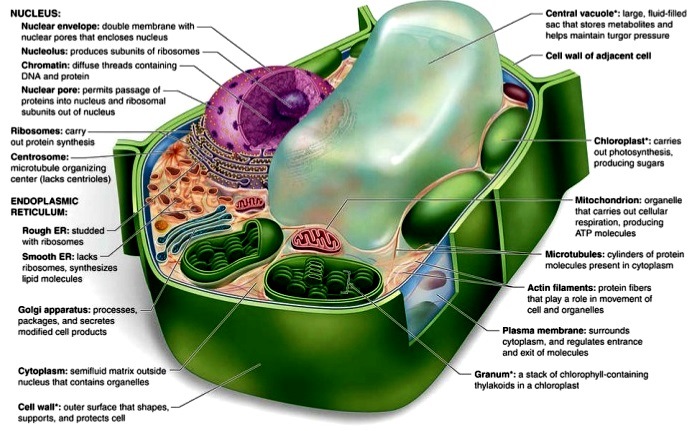
Plants and animal cells are composed of the same fundamental constituents—nucleic acids, proteins, carbohydrates, lipids, and various inorganic substances—and are organized in the same fundamental manner. A characteristic of their organization is the presence of unit membranes composed of phospholipids and associated proteins and, in some instances, nucleic acids. Various techniques, including cytochemistry, light and electron microscopy, and cell fractionation, have made it possible to visualize and define plant cell components and organelles (Fig. 2). Furthermore, specific enzyme activities in the organelles can be localized so that cell functions can be associated with definite cell structures. See also: Cytochemistry; Electron microscope; Enzyme
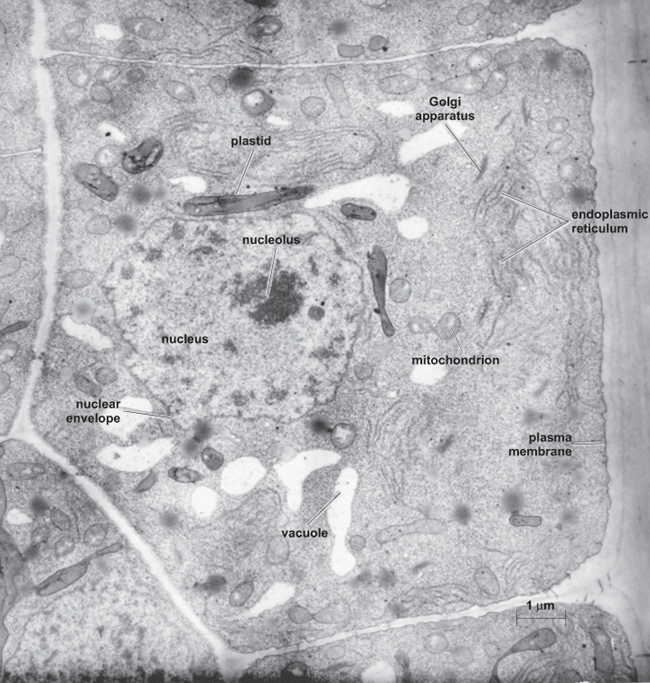
Plant cells arise only by division of preexisting cells. This observation also pertains to some of the compartments of cells, including the nucleus, mitochondria, and cell plastids. In most cases, the mitochondria and plastids appear to increase in number more or less concurrently with the division of the cell. Each is apparently also capable of increasing without cell division because cell differentiation following the period of cell growth is often characterized by increases in the number of one or more of these organelles. However, the manner in which other organelles (for example, the endoplasmic reticulum, Golgi apparatus, and vacuoles) behave in cell division is less clear. See also: Cell division
Plant cell growth
Sustained growth of the plant cell involves the participation of almost every organelle in the cell. Growth (Fig. 3) requires the simultaneous and coupled processes of cell wall loosening and water uptake. Sustained growth also requires the differential transcription of the deoxyribonucleic acid (DNA) in the nucleus, the translation of proteins in the ribosomes of the endoplasmic reticulum, adenosine triphosphate (ATP) produced by the mitochondria, and sugars produced by cell plastids. The two sides of a cell may grow at different rates in response to light and gravity during processes known as phototropism and gravitropism, respectively. See also: Plant growth; Plant movements
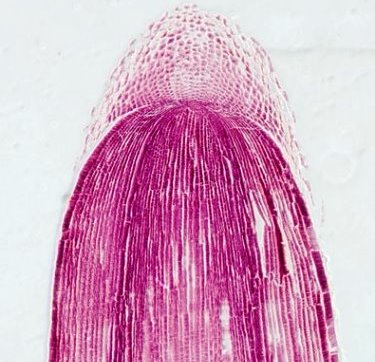
Plasma membrane
The cytoplasm is bounded externally by a membrane called the plasma membrane. Whereas the membranes of the compartments in the cytoplasm separate certain activities from the matrix, the plasma membrane separates the activities of the protoplast from the surrounding environment. The plasma membrane is a typical membrane composed of phospholipids and proteins and, as first evidenced from the study of plasmolysis, the plasma membrane is known to be selective with respect to the passage of ions and small molecules into or out of the cytoplasm. The lipids in the plasma membrane form a bilayer that is relatively permeable to hydrophobic molecules, but relatively impermeable to the nutritious hydrophilic charged ions and polar molecules. Membrane proteins known as channels and carriers facilitate the movement of charged ions and polar molecules across the plasma membrane. While some substances move across the plasma membrane passively down their electrochemical potential gradient, the movement of substances against their electrochemical potential gradient is active and requires the chemical energy of ATP. See also: Cell membranes; Ion transport; Lipid rafts (membranes); Plant protoplast
The plasma membrane is a very dynamic structure due to the rapid turnover of phospholipids and the activation of transport and signaling proteins in response to environment signals. Thus, the membranous barrier between the living cell contents and the environment, once thought to be a more or less passive structure, is really a very dynamic one.
Nucleus
The nucleus (Fig. 4) of the undifferentiated plant cell is generally centrally located; however, in mature plant cells, it may be displaced to the edge of the cell by the presence of a large vacuole. The nuclear material consists of clear regions, a fibrillar nuclear matrix, and chromatin, which at the time of division is resolved into chromosomes, a form suitable for transport. Nuclear components of key importance are DNA, ribonucleic acid (RNA), basic proteins known as histones that make up the nucleosomes around which the DNA is wrapped, and other proteins, including DNA polymerase, RNA polymerase, and transcription factors. Continuing syntheses of DNA and RNA are predominant activities in the nucleus, although comparable processes also take place in the mitochondria and the plastids. The singular importance of the relationships of DNA to RNA and proteins lies in the fact that the hereditary characteristics of the cell, encoded in DNA molecules, are transmitted in a complex sequence via RNA to proteins. See also: Cell nucleus; Deoxyribonucleic acid (DNA); Genetic code; Histone; Nucleic acid; Protein; Ribonucleic acid (RNA)
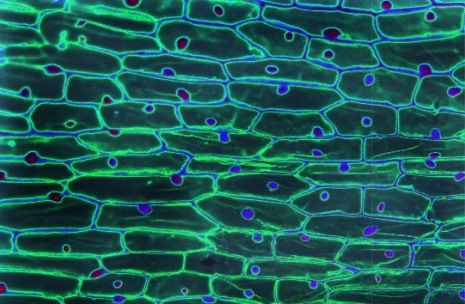
Different types of RNA are formed in the nucleus: transfer RNA (tRNA), ribosomal RNA (rRNA), messenger RNA (mRNA), and microRNA (miRNA). The first three participate in the synthesis of proteins by ribosomes and the last is involved in suppressing the synthesis of proteins. One or more nucleoli are found in the nuclei of all plant cells. Chemically, plant nucleoli contain DNA that codes for rRNA, the rRNA itself, and relatively large amounts of protein that will join with the rRNA to form the large and small subunits of the ribosomes. The appearance of the nucleolus changes through development.
Cytoplasm
The cytoplasm is the region of the cell between the nuclear envelope and the plasma membrane. It consists of a matrix throughout which are distributed various organelles and through which these organelles move. Metabolic activities may be generally distributed throughout the cytoplasm, confined to specific regions, or clearly carried out within the organelles. Although more research has been directed to the analysis of the chemical composition and activities of the organelles than of the cytoplasm, it is apparent that the cytoplasm is composed in part of cytoskeletal elements and chains of functionally related enzymes surrounded by the cytosol, which includes water, ions, small metabolites, and proteins. See also: Cytoplasm
The organelles, which are compartments in which certain metabolic activities are localized, are bounded by membranes similar to the plasma membrane. The molecular components (phospholipids and proteins) of the membranes are subject to rapid turnover. The membranes act as sites for the synthesis or breakdown of materials and frequently, as in mitochondria, are structurally highly specialized for these activities. Therefore, far from being simply selective barriers to the movement of materials, the membranes of the plant cell are dynamic structures that play key roles in metabolism.
Ribosomes
Conspicuous among the components of the cytoplasmic matrix are millions of particles, approximately 20 nanometers (nm) in diameter, known as ribosomes. Each ribosome is composed of a small subunit and a large subunit that are formed separately in the nucleolus from rRNA and proteins and brought together in the cytoplasm. The ribosomes are the sites of protein synthesis and function in translating the sequence of nucleotides in mRNA into the sequence of amino acids that make up the protein encoded by the mRNA. Translation of the genetic code in the ribosomes also requires tRNA. Smaller ribosomes are also present in the mitochondria and plastids, where they translate RNA encoded by the DNA that resides in these organelles. In all types of cells, some of the ribosomes in the cytoplasm appear to be free, whereas others are attached to the surface of the membranes of the endoplasmic reticulum or to the outer membrane of the nuclear envelope. See also: Ribosomes
Endoplasmic reticulum
The endoplasmic reticulum is an architecturally regular structure only in a few types of plant cells. It is a protean (highly variable) structure, and the manners in which its profiles are associated differ with the stage of development and metabolic activity. In certain stages, numbers of profiles are seen to be stacked, frequently parallel to the surface of the cell. The profiles may also surround the nucleus or seem to encompass any of several types of organelles. The endoplasmic reticulum may be smooth or rough; that is, the outer surfaces of the membranes may be studded with ribosomes. Although all plant cells have rough and smooth types of endoplasmic reticulum to synthesize the proteins and lipids necessary to construct many of the membranes of the cell, the rough endoplasmic reticulum is enriched in cells that are specialized for protein synthesis, including the cells of the aleurone layer of cereal seeds, and the smooth endoplasmic reticulum is enriched in cells specialized for lipid production, including oil gland cells and some stigmatic cells. Transitional endoplasmic reticulum, which is intermediate in structure between the smooth and rough endoplasmic reticulum, is rich in cells of the tapetum and the cells of seeds that store lipids in the form of osmotically active lipid bodies. See also: Endoplasmic reticulum
Golgi apparatus
The Golgi apparatus in many plant cells clearly functions in secretion, but the ubiquitous occurrence of the organelle suggests that it may have other roles in cellular activity. Although many aspects of its function are still obscure, it is apparent that certain materials are sequestered into its cisternae or saccules, synthesized there, or variously combined in the cisternae to form complex secretion products. The secretory products are then separated from the cisternae as membrane-bound vesicles and transported to and through the plasma membrane or to the vacuolar compartment where they remain inside the cell. While the Golgi apparatus is important in the secretion of many proteins, including the fucose-rich mucilage secreted by root cap cells, the digestive enzymes secreted by insectivorous plants, and the wall-degrading enzymes released by the cells in the abscission zone, it is bypassed in the secretion of some proteins, including the prolamin proteins that make up some of the protein vacuoles in the seeds of cereals. In the majority of plant cells, the Golgi apparatus is responsible for packaging and exporting the hemicelluloses, pectins, and hydroxyproline-rich glycoproteins of the wall that is built up around the cell. See also: Golgi apparatus
Vacuoles
The vacuole (Fig. 5) is a membrane-bound compartment in the cell that contains the cell sap. In meristematic cells, vacuoles are generally small and are characterized by contents that stain darkly with certain procedures. The contents of these vacuoles seem to be utilized in the process of development and then are replaced by water. At a certain stage in this process, the vacuoles fuse to form the large central vacuole, and most mature plant cells have large, centrally located vacuoles that make up the greatest part of the total volume of the cell. The cell sap is typically clear, making the vacuole look empty or vacuous. The increase in volume of this vacuole is important in the growth of the plant cell. Moreover, the presence of water in the vacuole allows plants to have a large open dendritic form with a minimum investment of energy-intensive compounds in order to help the plants acquire light and the necessary nutrients that are dilute in the environment. In plant cells, vacuoles of different sorts are known to have different origins, with the endoplasmic reticulum, the Golgi apparatus, and the plasma membrane being involved. See also: Vacuole
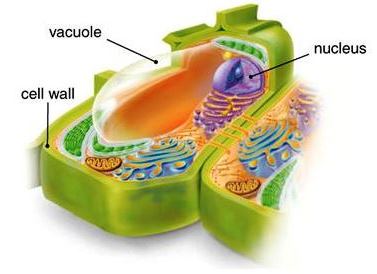
Vacuoles participate in the homeostasis of the cytosol by acting as large reversible stores of water, protons and other ions, amino acids, and other metabolites. The vacuoles in cells of many seeds function in the storage of proteins, and the vacuoles in the cells of many desert plants function in the storage of water as well as the storage of carbon in the form of organic acids. In addition, the colors of many flowers and fruits result from the presence of pigments dissolved in the vacuolar fluid. See also: Plant pigment
Lipid bodies
Another conspicuous feature of many types of plant cells is the presence of large numbers of lipid bodies or spherosomes. They frequently are abundant in cells of embryos or in root or shoot apices and less numerous in more mature plant cells. These bodies are unique in having a structural boundary that is composed of a monolayer instead of a bilayer that is typical of most membranes. The lipid bodies provide a carbon source for the production of biofuels. See also: Lipid
Mitochondria
Mitochondria typically are ellipsoidal bodies bounded by a double-membrane system with the inner membrane projecting into the lumen to form cristae (Fig. 6), which may be either tubular or sheetlike, depending upon the type of cell and its activity. In general, there is less extensive development of the cristae in the mitochondria of plant cells than in those of animals. This may reflect the fact that plant cells generally have substantially lower respiratory rates. In the few types of plant cells characterized by relatively high respiratory rates, the extent of the cristae more nearly resembles that in animal cells. The inner membrane of the mitochondria surrounds the matrix. The mitochondria can often be observed to move incessantly throughout the plant cell. See also: Mitochondria
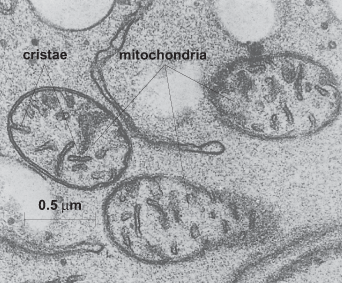
The mitochondria are the respiratory centers of the cell where the energy released by the combustion of carbohydrates is conserved in the synthesis of ATP from adenosine diphosphate (ADP) and inorganic phosphate (Pi). The conversion of the chemical energy of carbohydrate to the chemical energy of ATP requires a few associated processes. The pyruvate formed during glycolysis, which takes place in the cytosol, is oxidized to carbon dioxide (CO2) in the matrix of the mitochondria in a process known as the Krebs cycle or the citric acid cycle. The electrons captured in the oxidation process are transported down electron transport chains in the inner membrane. Molecular oxygen is the final receptor for these electrons. The energy extracted by the ATP synthase is used for the production of ATP. See also: Citric acid cycle
Plastids
Perhaps the most conspicuous and certainly the most studied of the features peculiar to plant cells is the presence of plastids. The plastids are bounded by an envelope consisting of two membranes that touch in regions known as contact sites and an inner membrane system immersed in a viscous gel known as the stroma. Chlorophylls and other pigments are associated with the inner-membrane system. The extensiveness of the inner membrane varies greatly with the functional state of the plastid. The inner membranes of chloroplasts known as the thylakoids are characterized in most plants as associations of stacked disk-shaped granal lamellae and interconnecting stromal lamellae (Fig. 7). The chlorophylls, or green pigments, have been the most studied of the plant pigments because of their conspicuous role in photosynthesis, the process in which radiant energy is converted into the chemical energy of carbohydrates. See also: Cell plastids; Chlorophyll; Photosynthesis
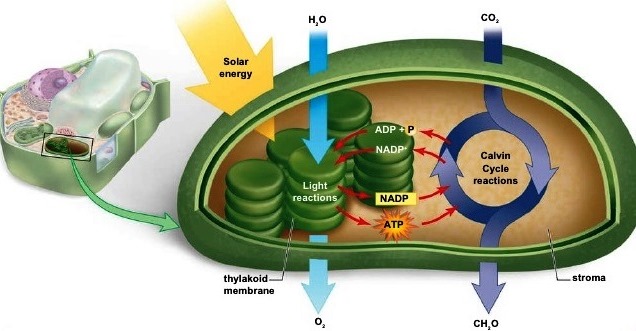
The plastids, which can metamorphose into each other, exist in a splendid array of shapes and colors. The green plastids, which are known as chloroplasts, contain chlorophyll, which is responsible for the green color of many parts of plants. In higher plants, chloroplasts are typically ellipsoidal; in contrast, in the algae, they may appear as plates, stars, or spirals. The orange plastids, which are known as chromoplasts, contain carotenoids and are responsible for certain colors in flowers, fruits, the roots of carrots and sweet potatoes (Ipomoea batatas), and the stem tubers of yams (Solanum tuberosum). The translucent plastids also known as leucoplasts include the amyloplasts and the elaioplasts, in which starch and lipids, respectively, are stored. In higher plants, the plastids originate as small proplastids in the meristematic cells. The transformation of proplastids into chloroplasts in higher plants requires light. In the absence of light, the proplastids transform into etioplasts, which will rapidly become chloroplasts upon exposure to light. See also: Carotenoids
Cell wall
A distinctive feature of the plant cell (Fig. 8) is the rigid wall surrounding the cell outside the plasma membrane. While the wall may be variously thickened and sculptured in mature cells, it is only 100 nm thick in meristematic cells. The cell wall provides the mechanical strength that allows plant cells to build up turgor pressure without lysing when surrounded by dilute media. This turgor pressure makes it possible for herbaceous plants to stand erect. See also: Cell walls (plant)
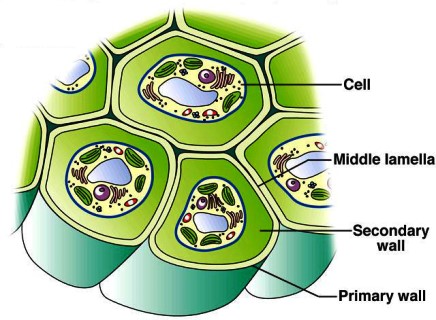
The cell wall or extracellular matrix is a network of polymers composed of cellulose microfibrils, hemicelluloses, pectins, hydroxyproline-rich glycoproteins, and the enzymes used to build and modify the cell wall. The cell wall is formed in two stages; because of this, the botanist generally distinguishes between a primary wall and a secondary wall. The primary cell wall is laid down at the time of cell division and extended during cell growth. The secondary wall is laid down after the cell has ceased to grow and may vary greatly in structure and composition. The secondary cell wall has more cellulose than the primary wall and sometimes contains substantial amounts of lignin and other substances. In certain types of cells, the secondary wall is uniformly thickened; in others, it is thickened in bands or in spiral patterns; and in still others, the thickenings are only at the corners. The wall surrounding a given cell can differ in composition on different sides of the cell, and a given pattern can change throughout development. How this occurs remains a mystery.
While the cell wall may be referred to as the extracellular matrix, it is intimately connected with the rest of the cell through proteins in the plasma membrane known as integrins that connect proteins in the extracellular matrix to proteins that make up the cytoskeleton. The extracellular matrix–plasma membrane–cytoskeletal continuum is used by plant cells to sense gravity and by fungal cells to sense the epidermal cell pattern on leaves that facilitates the directional growth of the mycelium and the formation of appressoria (penetrating structures).





